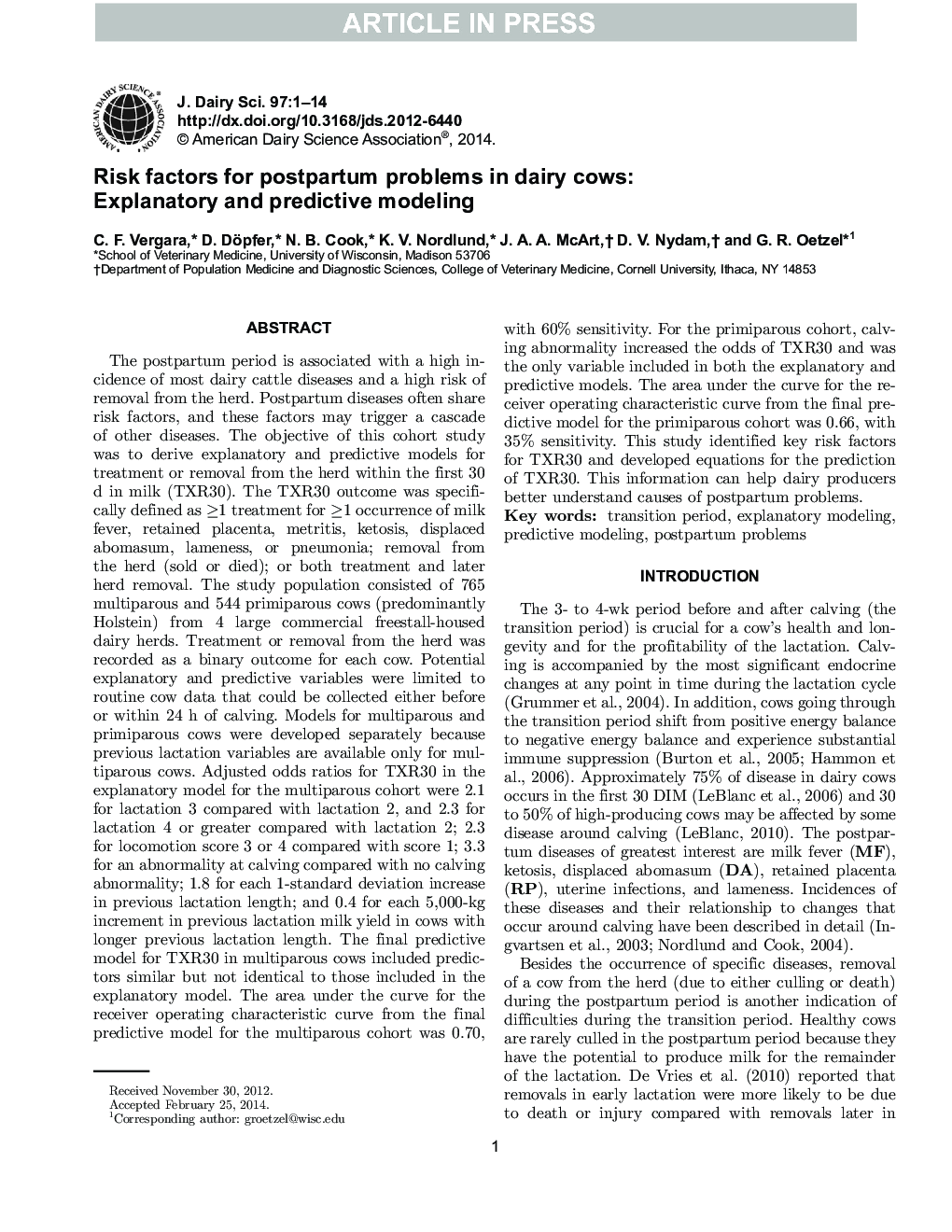| کد مقاله | کد نشریه | سال انتشار | مقاله انگلیسی | نسخه تمام متن |
|---|---|---|---|---|
| 10976282 | 1108040 | 2014 | 14 صفحه PDF | دانلود رایگان |
عنوان انگلیسی مقاله ISI
Risk factors for postpartum problems in dairy cows: Explanatory and predictive modeling
ترجمه فارسی عنوان
عوامل خطر برای مشکلات پس از زایمان در گاوهای شیری: مدل سازی توضیحی و پیش بینی شده
دانلود مقاله + سفارش ترجمه
دانلود مقاله ISI انگلیسی
رایگان برای ایرانیان
کلمات کلیدی
دوره گذار، مدل سازی توضیحی مدل سازی پیش بینی شده، مشکلات پس از زایمان،
موضوعات مرتبط
علوم زیستی و بیوفناوری
علوم کشاورزی و بیولوژیک
علوم دامی و جانورشناسی
چکیده انگلیسی
The postpartum period is associated with a high incidence of most dairy cattle diseases and a high risk of removal from the herd. Postpartum diseases often share risk factors, and these factors may trigger a cascade of other diseases. The objective of this cohort study was to derive explanatory and predictive models for treatment or removal from the herd within the first 30 d in milk (TXR30). The TXR30 outcome was specifically defined as â¥1 treatment for â¥1 occurrence of milk fever, retained placenta, metritis, ketosis, displaced abomasum, lameness, or pneumonia; removal from the herd (sold or died); or both treatment and later herd removal. The study population consisted of 765 multiparous and 544 primiparous cows (predominantly Holstein) from 4 large commercial freestall-housed dairy herds. Treatment or removal from the herd was recorded as a binary outcome for each cow. Potential explanatory and predictive variables were limited to routine cow data that could be collected either before or within 24 h of calving. Models for multiparous and primiparous cows were developed separately because previous lactation variables are available only for multiparous cows. Adjusted odds ratios for TXR30 in the explanatory model for the multiparous cohort were 2.1 for lactation 3 compared with lactation 2, and 2.3 for lactation 4 or greater compared with lactation 2; 2.3 for locomotion score 3 or 4 compared with score 1; 3.3 for an abnormality at calving compared with no calving abnormality; 1.8 for each 1-standard deviation increase in previous lactation length; and 0.4 for each 5,000-kg increment in previous lactation milk yield in cows with longer previous lactation length. The final predictive model for TXR30 in multiparous cows included predictors similar but not identical to those included in the explanatory model. The area under the curve for the receiver operating characteristic curve from the final predictive model for the multiparous cohort was 0.70, with 60% sensitivity. For the primiparous cohort, calving abnormality increased the odds of TXR30 and was the only variable included in both the explanatory and predictive models. The area under the curve for the receiver operating characteristic curve from the final predictive model for the primiparous cohort was 0.66, with 35% sensitivity. This study identified key risk factors for TXR30 and developed equations for the prediction of TXR30. This information can help dairy producers better understand causes of postpartum problems.
ناشر
Database: Elsevier - ScienceDirect (ساینس دایرکت)
Journal: Journal of Dairy Science - Volume 97, Issue 7, July 2014, Pages 4127-4140
Journal: Journal of Dairy Science - Volume 97, Issue 7, July 2014, Pages 4127-4140
نویسندگان
C.F. Vergara, D. Döpfer, N.B. Cook, K.V. Nordlund, J.A.A. McArt, D.V. Nydam, G.R. Oetzel,
